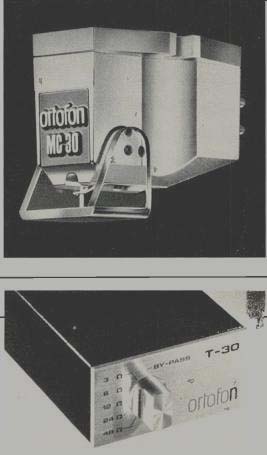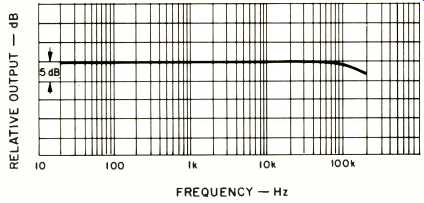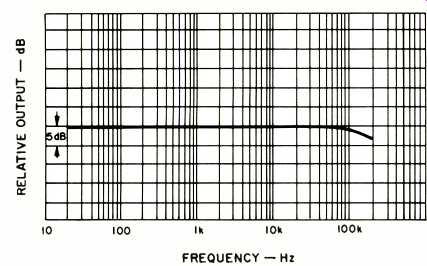
Manufacturer's Specifications:
Voltage Output at 1 kHz, 5 cm/S: 0.08 mV (80 uV).
Internal Impedance D.C. Resistance: 3 ohms/channel.
Recommended Load Impedance per Channel: 47 kilohms.
Vertical Tracking Angle: 20 degrees.
Frequency Range: 5 to 60,000 Hz.
Frequency Response: 20 to 20,000 Hz ±1 dB.
Channel Separation at 1 kHz: 25 dB min.
Channel Separation at 15 kHz: 20 dB min.
Channel Balance: 1 dB max.
Dynamic Compliance at 10 Hz: Horizontal, 13 x 10^-6 cm/dyne; vertical, 13 x 10^-6 cm/dyne.
Tracking Ability at 315 Hz at Recommended Tracking Force: 75 N m.
FIM Distortion at Recommended Tracking Force, DIN 45 500: 1 percent.
Weight: 7 grams.
Type of Stylus: Fine-Line (modified Shibata).
Stylus Tip Radius: 6 N m.
Equivalent Stylus Tip Mass: 0.4 mg.
Recommended Tracking Force: 1.5 grams.
Price: $600.00.
-------------------------
T-30 Transformer
Type: Toroidal.
Input Loading: 3, 6, 12, 24 or 48 ohms and by-pass.
Output Loading: 47 kilohms and 150 pF.
Frequency Response: 4 to 120,000 Hz, +0.3,-3 dB.
Gain: 20 to 32 dB.
Channel Separation: 5 Hz to 50 kHz, 50 dB, 5 Hz to 30 kHz, 60 dB.
Channel Balance: 0.2 dB.
Square-Wave Rise Time: 3 uS.
Phase Linearity: 10 Hz to 25 kHz, ±15 degrees.
Price: $500.00.
Although the principle of a moving-coil generator is quite old, as it was known in the days of Edison, Henry, and Tesla, the first moving-coil cutterhead was not produced until 1945. With Ortofon introducing its first moving-coil cutterhead in 1945, it didn't take long before people realized that there was no phono cartridge on the market good enough to provide sufficient challenge to the "new type" cutterhead. Thus, in 1948 Ortofon introduced the first moving-coil phono cartridge, a mono unit, with features that matched the quality level of their cutterhead.
The outward appearance of the Ortofon-MC 30 moving-coil cartridge is not unlike its predecessors, and it can be identified by its gold color. However, the design is quite different, i.e., newly designed cantilever, armature, coils, and a unique new damping system known as the "wide range damping" (WRD) system, which selectively damps resonances in the mechanical system and consists of two layers of special rubber with a platinum disc between them. At low frequencies the two rubber bearings enable the cantilever to make wide movements, while at higher frequencies the platinum disc acts as a sort of brake, progressively damping the movements with increases in frequency, so that at very high frequencies only the front rubber bearing is working. The MC-30 is highly compliant at low frequencies, and at high frequencies the design permits damping to be exerted. The newly designed, thin-walled aluminum alloy cantilever has fixed to it a 0.1-mm square nude diamond of Fine-Line (modified Shibata) shape which makes vertical contact with the groove wall over a wider surface than is done with elliptical or conical shapes. Further cantilever design permits the horizontal and vertical compliance to be identical, with a lower effective tip mass. The weight of the moving coils has been reduced by using copper wire of 30-micron diameter with only 20 turns per layer. Because of the minute size of the moving coils, the signal output is very low, and a step-up device is needed to raise the output voltage to a level that can be used with the usual preamplifier phono input stages. This step-up can be accomplished with a transformer or a pre-preamplifier, such as Ortofon's T-30 transformer or MCA-76 or MCA-10 pre-preamplifiers.
Measurements

Fig. 1--Frequency response of the Ortofon T-30 transformer.
The MC-30 cartridge was mounted in a Technics headshell and used with the Technics EPA-100 tonearm mounted on a Technics SP-10 MkII turntable. Voltage step-up was via the MCA-76 pre-preamplifier as well as the T-30 transformer Be cause the T-30 transformer was specially designed for the MC-30 phono cartridge, we decided to make all our measurements using the transformer and tested its frequency response from 30 Hz to 200 kHz to make certain that its output was flat to at least 50 kHz. The measured response was superb,-0.4 dB at 30 Hz, then slowly rising to 0 dB by 2(X) Hz and continuing at this level to 20 kHz, descending to-1 dB at 80 kHz,-1.75 dB at 100 kHz, and-3.5 dB at 200 kHz. The measured gain was 32 dB at the 3-ohm tap.
All measurements of the cartridge were made at a vertical tracking force of 1.5 grams, as recommended by the manufacturer, and with an anti-skating force of 1.7 grams. We might mention that our laboratory findings showed that a vertical tracking force of 1.7 grams and an anti-skating force of 2 grams improved the low-frequency trackability of the MC-30. However, we do not recommend a tracking force greater than 1.5 grams, as suggested by the manufacturer. During the test period the average ambient temperature was 79 degrees F, ±1 degree (26.11 degrees C) and the relative humidity was 60 percent, ±3 percent.

Fig. 2--Frequency response, left channel, and separation of Ortofon MC-30
moving-coil cartridge.
To obtain cartridge/stylus lateral alignment to better than 0.003 in. and optimum tracing of the record groove, we oriented the MC-30 in the headshell and tonearm with the Dennesen Geometric Soundtracktor ( Box 51, Beverly, Mass. 01915). This stylus alignment tool compensates for any errors made in the tonearm design and manufacture, and automatically sets the appropriate overhang for any pivoted tonearm effective length.
Frequency response, using the Columbia STR-170 test record, is flat within ±0.5 dB from 40 Hz to 3 kHz, then rises to +1 dB at 5 and 6 kHz, dropping to 0 dB at 10 kHz, then again rising to +0.75 dB at 20 kHz. Its overall frequency response is +1 dB,-0.5 dB from 40 Hz to 20 kHz. Separation is 22 dB at 1 kHz, 21.75 dB at 10 kHz, 18.5 dB at 15 kHz, and 18 dB at 20 kHz. This separation is quite adequate for a well defined stereo effect on playback.
The response to a 1-kHz square wave shows very little overshoot followed by ringing that decayed rapidly, with a stylus resonance of 41 kHz. This type of square-wave response is common with cartridges having an extended frequency response. The cartridge-arm low-frequency resonance was at 10 Hz and of 2.5 dB amplitude with the Technics EPA-100 tonearm. The vertical resonance was about 12 Hz in the same arm. In view of the low-frequency resonance, it is recommended that the MC-30 be used only in tonearms of medium to low mass.
The following test records were used in making the reported measurements: Micro-Acoustics TT-2002; Shure TTR-103, TTR-109, TTR-110, and TTR-115; Columbia STR-170, STR-100, STR-112, and SQT-1100; Deutsches Hi-Fi No. 2; Nippon Columbia Audio Technical Record (PCM) XL-7004, and Ortofon Direct-Cut Pickup Test Record 0001.
Wt., 6.56 g; d.c. res., 3.097 ohms; tracking force, 1.5 g; anti-skating force, 1.7 g; output (using T-30 transformer), 1.07 mV/ cm/S; IM distortion: (4:1) +9 dB lateral, 200/4000 Hz, 1.8 per cent; +6 dB vertical, 200/4000 Hz, 2.8 percent; crosstalk (using Shure TTR-109), 27 dB; channel balance, 0.25 dB; trackability: high freq. (10.8 kHz pulsed), 30 cm/S, mid-freq. (1000 + 1500 Hz, lat. cut), 31.5 cm/S; low freq. (400 + 4000 Hz, lat. cut), 24 cm/S; Deutsches Hi-Fi No. 2 300-Hz test band was tracked cleanly to 77 microns (0.0077 cm), lateral at 14.5 cm/S at +8.7 dB and 55.4 microns (0.00554 cm), vertical at 10.32 cm/S at +5.86 dB. The latter measurements are relatively good, especially the vertical measurement, because not many cartridges can track the higher 300-Hz bands on this test record.
The Ortofon MC-30 along with its T-30 transformer was able to play all the tracking and transient ability bands on the Micro-Acoustics TT-2002 musical test record. The Shure Obstacle Course- Era III test record offered no challenge to the MC-30. The Shure Obstacle Course-Era IV gave the cartridge a workout, and only on band 5 of the harp and flute combination did the MC-30 become slightly strident with a hint of possible breakup. The MC-30 performed superbly inasmuch as very, very few cartridges are able to cleanly play all the bands on the Era IV test record.
Listening and Use Tests
We perform our listening tests both before and after measurement. Unequivocally, the MC-30 has excellent transient response, sonic clarity, and transparency of sound. We did not find it to be bright despite the 1-dB rise in the 5- to 7-kHz region, and the bass was sonically well-defined and tight. Separation was rather well maintained, going beyond 20 kHz.
In the course of our listening tests, we used both Ortofon's T-30 transformer and the MCA-76 pre-preamplifier. Upon prolonged listening, we came to the conclusion that the superior characteristics of the MC-30 were not fully realized with either of these devices. Subsequently, we listened to the cartridge with the Mark Levinson JC-1DC pre-preamplifier and the new Audio Standards Corp. MX-10/A pre-preamplifier. The Levinson is, of course, a well-known unit and of excellent quality, but with the MC-30 the MX-10/A was clearly the unit of choice, as it neither detracted from nor embellished the virtues of the MC-30. Although we found the MC-30 to work quite well with all the step-up devices we tried, we concluded that the MC-30 and MX-10/A combination was superior to all the other combinations we tried.
Because of the excellent sonic quality of the MC-30, we evaluated it over a longer period than any other cartridge we have tested. We finally concluded that until something better comes along, the Ortofon MC-30 is the top moving-coil cartridge available today.
-B.V. Pisha.
=======================
Evaluation Equipment and Records
Besides the step-up devices mentioned earlier, the following additional equipment and specific records listed below, as well as many discs listed in past reports, were utilized in the listening evaluation of the MC-30 phono cartridge. The Technics SP-10 MkII turntable, Technics EPA-100 tonearm, Nikko Beta 1 preamplifier, Crown IC-150A preamplifier, the about-to-be marketed Audio Standards Corp. MSC-1 preamplifier, the Audire DM-700 power amplifier, a pair of stacked Duntech DL-15B speakers in each channel, and a Columbia SQL-400A SQ decoder. Each pair of speakers was connected to the Audire DM-700 power amplifier with PolkSound Cables using a Polk RC terminating network at the speaker end of each cable. The turntable was equipped with the Hiraoka Disk-SE22 turntable mat.
The following records were among those used to aurally assess the performance of the Ortofon MC-30 moving-coil phono cartridge:
Stereo
Bethel College Male Chorus, Mogck- Ark Recording Co. ( Minneapolis, Minn. 55442) 4079-5.
Caballé Sings Wagner, Lombard, Strasbourg Philharmonic Orchestra- RCA (Erato) ARL1-3351.
Verdi Overtures, Abbado, London Symphony Orchestra--RCA ARL1-3345.
Brahms: Sacred and Secular Choral Music, Corboz, Chorus of the Gulbenkian Foundation of Lisbon- RCA ARL2-3350.
Puccini: La Bohéme (Caballé, Domingo, Milnes), Solti, London Philharmonic Orchestra-RCA ARL2-0371.
J. Strauss: Graduation Ball, Dorati, Vienna Philharmonic Orchestra- London CS 7086.
Stokowski Conducts Mahler: Symphony 2, "Resurrection," London Symphony Orchestra and Chorus--RCA ARD2-0852.
Mehta, Bolero, Sensational Orchestral Showpieces, Mehta, Los Angeles Philharmonic-- London CS 7132.
Direct to Disc
Black Octopus, Paul Jackson- Toshiba-EMI EW L F-98006.
Orchestrations Astromantic, Otaka, Tokyo Philharmonic- RCA ( Japan) RDCE-6.
Benny Goodman "The King"- Century Records CRDD-1150.
Evolutions I, Jon Jarvis,- Crystal Clear Records CCS 8004.
Flamenco Fever- M & K RealTime Records RT-107.
Hot Stix, Ed Graham-M & K RealTime Records RT-106.
Beethoven: Ode to Joy from 9th Symphony, Mitzelfelt, Los Angeles Camerata Symphony Orchestra and Chorus-M & K RealTime Records RT-112.
The Power and the Glory (Vol. 1), Holzgraf (organist)-M & K RealTime Records RT-114.
Excitin' Latin!, Misago and His Cuban Boys--Toshiba/EMI LF-95013.
Times Gettin' Tougher than Tough, Musselwhite--Crystal Clear Records CCS 5005.
Pulse Code Modulation (PCM) Digital to Analog
Especially for You, Alex Blake, PCM Jazz in New York-Denon YX-7549-N D.
Knowledge of Self, Billy Harper, PCM Jazz in New York--Denon YX-7801-N D.
Generations Suite, Bridgewater Brothers, PCM Jazz in New York--Denon YX 7802-ND.
Mozart: Symphonies No. 38, " Prague," and No. 36, " Linz," Suitner, NHK Symphony Orchestra--Denon OX-7156-ND.
Aprés Un Reve-Romantic Cello Miniatures, Fujiwara, cellist--Denon OX-7147-N D.
Dvorák: The Complete Piano Trios, Suk Trio--Denon OQ-7440-42-ND.
J.S. Bach: Inventions and Sinfonias, BWV 772/801, Dreyfus (Harpsichordist)--Denon OX-7150-N D.
Schubert: String Quartets No. 14, "Death and the Maiden," and No. 10, "Allegro," Smetana Quartet- Denon OX-7151-ND.
Danzas Fantásticas, Gould, London Symphony Orchestra--Chalfont SDG 302. (Denon records are distributed by American Audioport, Inc., Columbia, Mo. Chalfont records, Los Angeles, Cal. 90048.) Quadraphonic—SQ
The Concert of the Century- Columbia M2X 34256.
Three Penny Opera-Columbia PS 34326.
Secrets, Herbie Hancock- Columbia PCQ 34208.
=========================
(Audio magazine, Nov. 1979)
Also see:
Ortofon MC 2000 Phono Cartridge and T 2000 Transformer (Equip. Profile, Dec. 1984)
Panasonic Strain-Gauge (Semiconductor) Cartridge (Aug. 1974)
Micro Acoustics 630 Phono Cartridge (Mar. 1984)
Phono Equalization Kits--various models (Mar. 1979)
= = = =